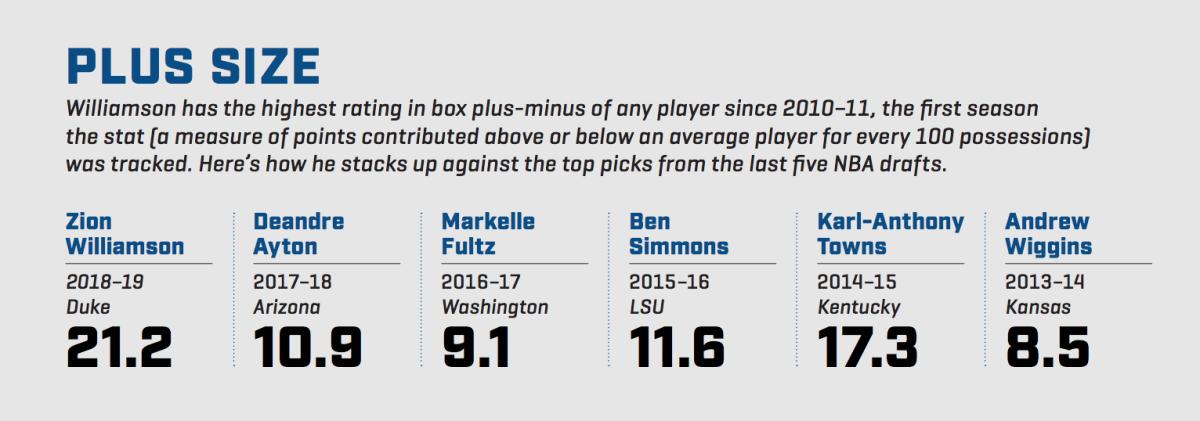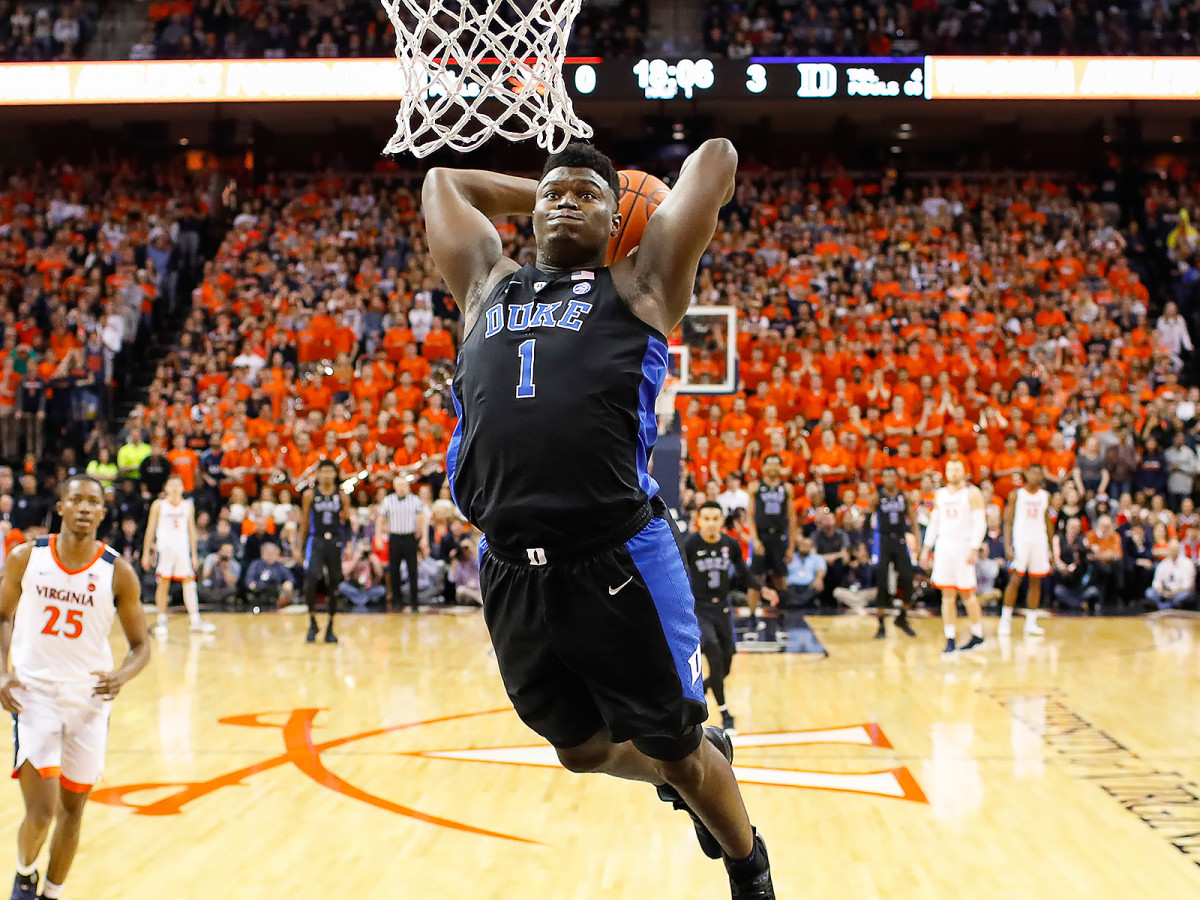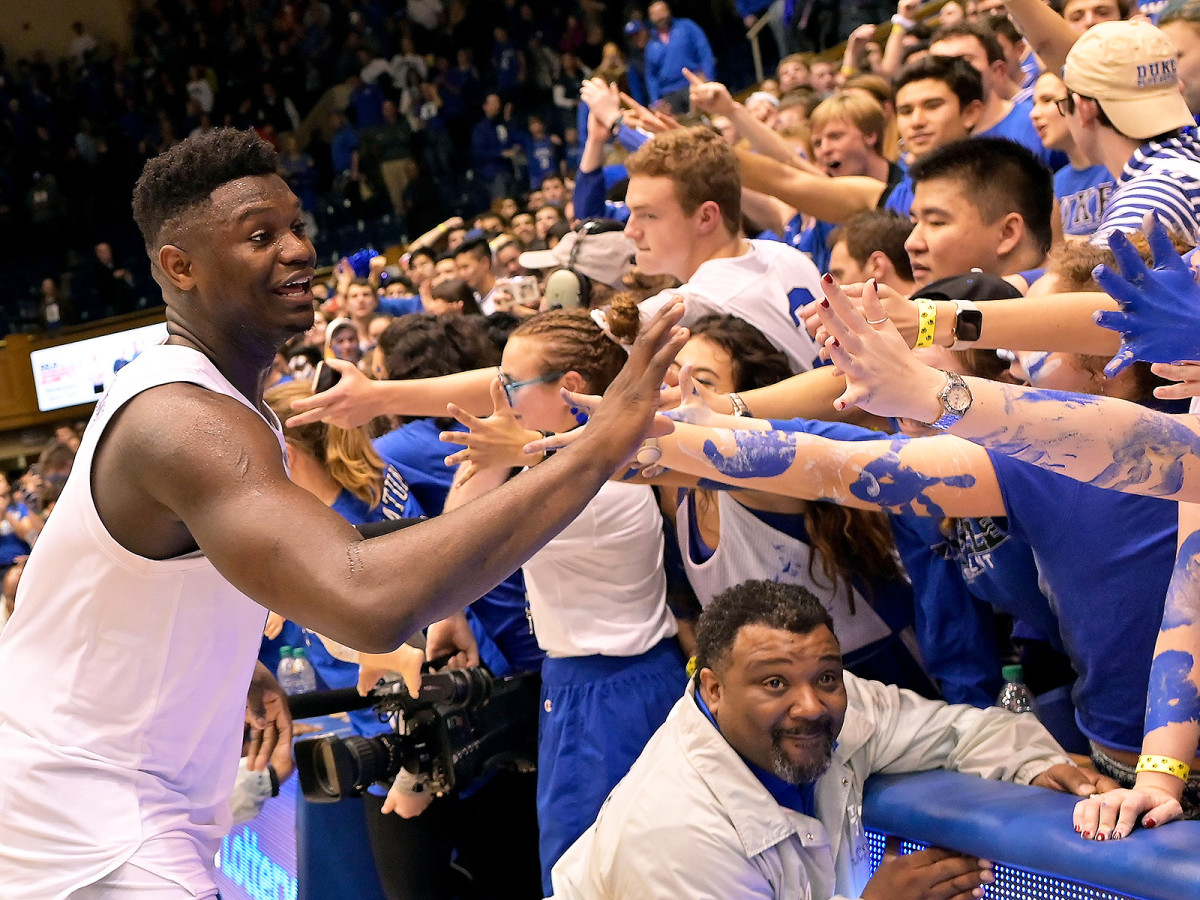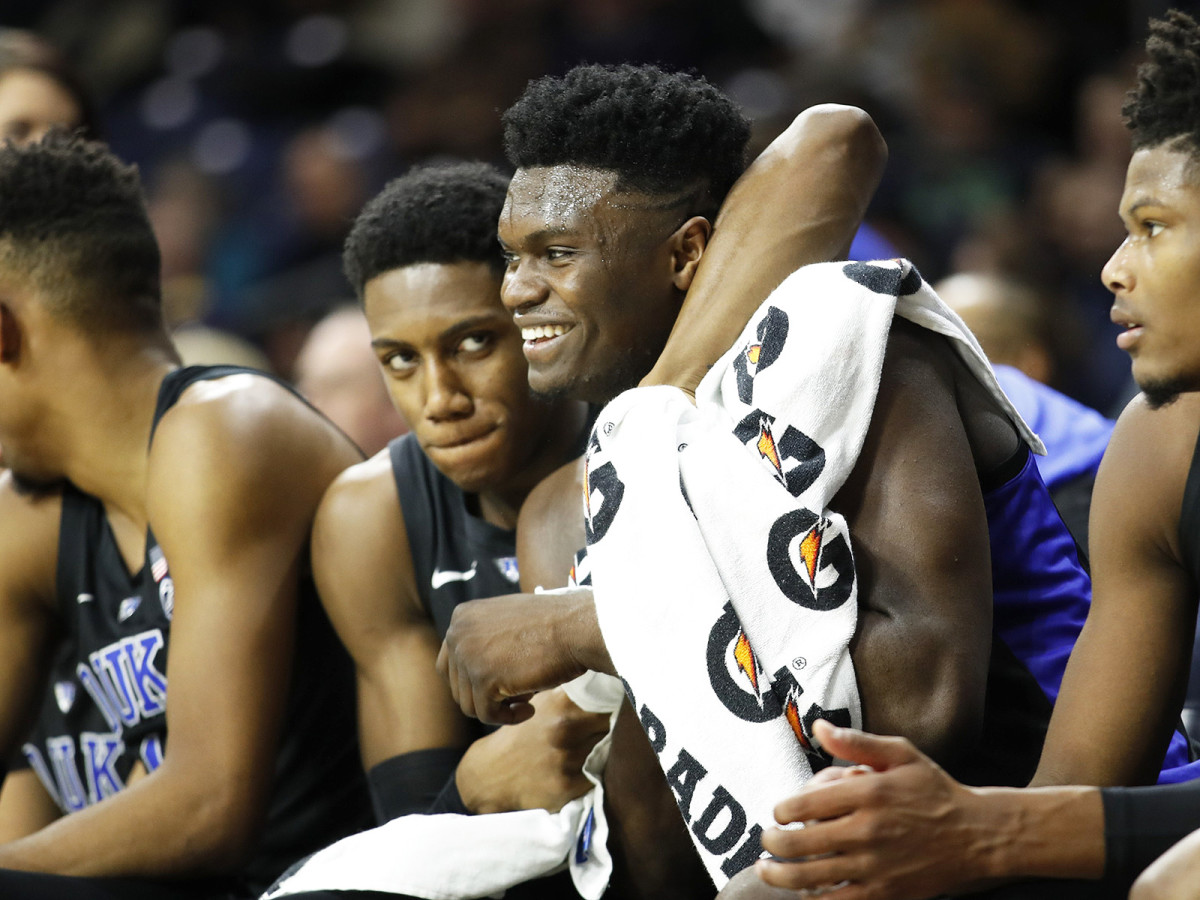Zion Williamson's Year at Duke Will Stand Apart From His Legendary Past and Limitless Future

*****
This story appears in the March 11, 2019, issue of Sports Illustrated. For more great storytelling and in-depth analysis, subscribe to the magazine—and get up to 94% off the cover price. Click here for more.
Four months. That’s all the time Zion Williamson needed to break college basketball—a mere 26 games, exactly 732 minutes on the floor. What, you’re not buying it based on the 360-degree dunks and the nimble coast-to-coast drives and the 2.5 million Instagram followers and the ex-Presidents in the seats at Duke’s Cameron Indoor Stadium? Then look at the box scores: an average of 21.6 points, 8.8 rebounds, 2.2 assists, 2.2 steals and 1.8 blocks while shooting a preposterous 68.3% from the field, a combination of thresholds no college player on record has achieved over a full season.
Or ponder the deeper analytics: In the nine years that box plus-minus has been kept, Williamson’s rating is more than 13% higher than the previous best, set by Anthony Davis in 2011–12. Williamson’s win shares per 40 minutes, a stat kept since 2010, would be a record too.

Or listen to the reviews from the sage old—and not so old—basketball men. North Carolina’s Roy Williams, who has coached in either the ACC or Big 12 every season since 1978, said of Williamson’s blend of power, speed and athleticism, “In the college game, I’ve never seen it.” Kevin Durant: Williamson is “a once-in-a-generation type athlete.” John Wall: He’s “one of the top two, three most athletic players I’ve ever seen.” Duke assistant Nate James sees higher powers at work: “I serve a lord that does miraculous things, and I think one of the miraculous things he’s done is create a kid that size that does what he does.”
Ah, yes, that size. At 18, Zion Williamson has already distorted expectations for how a teenage baller—any baller—should be built and how he should be able to move. He’s 6' 7", but so broad and muscular, his height is beside the point. He’s listed at 285 pounds, but that must be a misprint. How can someone weigh five pounds more than an All-Pro defensive tackle (Aaron Donald) and also have a greater vertical leap than one of the NBA’s dunking legends (Vince Carter)? Godzilla powered by Flubber, choreographed by Fred Astaire.

The highlights he produces, his bursts of elegance and violence, are cinematic too. There was the January play against Clemson where he picked a ballhandler’s pocket at midcourt, reached the lane in two dribbles and flushed a flawless 360-degree tomahawk dunk with his left hand. And the end-to-end fast break he led against Virginia two weeks later where he deftly maneuvered between a quartet of defenders without breaking stride and threw down righty while being hacked by a 7-footer. And the block—the Block—in Duke’s rematch with the ’Hoos where, in the time it took 6' 7" De’Andre Hunter to catch the ball, set his feet and launch a corner three, Williamson sprinted from the far side of the lane more than 25 feet away, leaped and reached about 12 feet in the air to full-palm swat the shot out of bounds.
It’s moments like that that led Notre Dame coach Mike Brey to label Williamson “a freak of nature” and why the NBA lottery—Williamson is the presumed No. 1 pick—will be full of franchises that have successfully executed Not Tryin’ for Zion tanking plans. The 2018–19 college basketball season will forever be known as the Season of Zion. His biggest impact on the sport, though, may not come in the ways he has broken college basketball. It may come out of the moment when college basketball nearly broke him.
February 20. Duke–North Carolina at Cameron Indoor, the No. 1 team in the country versus No. 8, with tickets going for a Super Bowl–like $2,500 a pop and the likes of Barack Obama, Spike Lee and Ken Griffey Jr. in the seats. Williamson wasn’t the only attraction—Duke’s starting five also includes R.J. Barrett and Cam Reddish, two other likely top five picks in this NBA draft. But there was no question about who the game’s main attraction was, which is why the evening will be remembered more for what happened 30 seconds after tipoff than for the Tar Heels’ 88–72 win. Williamson gathered the ball and dribbled across the free throw line, planted his left foot for a spin move ... and went down in a heap when his left foot burst through its sneaker. Williamson limped off to the locker room. The rest of the world—Twitter, anyway—cringed that the best college basketball player in a generation may have torn an ACL. The notorious busted shoe—a white Nike PG 2.5, its sole entirely cleaved from its upper and toe box along the outside—had not yet left its resting place under a folding chair on the Duke sideline that night before bigger-picture chatter began. Within the hour Jazz guard and Louisville alum Donovan Mitchell tweeted a reminder to “remember all the money that went into this game ... and these players get none of it.” The next day Warriors center and former Kentucky star DeMarcus Cousins took it a step further, telling reporters, “Knowing what I know now ... college basketball, the NCAA, is bulls---.”
Williamson was diagnosed with a right-knee sprain—a less-than-serious injury, though he hasn’t played since. In the end, it wasn’t Williamson’s potential earning power that took the biggest hit; the next day Nike’s stock dropped 1%, losing $1.37 billion in value. (And, as has been widely noted, Williamson reportedly holds an $8 million insurance policy should he fall outside of the NBA’s top 16 draft picks.) But even an injury that proved to be milder than originally feared became a prism into the larger issues facing college sports. Should he, like a number of bowl-skipping college football players, protect his health and draft status by sitting out the rest of the season? For that matter, should Williamson have been forced to play college basketball at all? A few days after Williamson’s shoeburst, the NBA reportedly (and coincidentally) sent a proposal to the players’ union that would lower the league’s draft-eligible age from 19 to 18—a rule that, if in effect last year, would have allowed Williamson to jump straight from high school to the pros. (Williamson has said that he would have played a year in college no matter what the rule was.)
The draft eligibility age is a worthy debate—the NBA adopted the age-19 policy in 2005—but in Williamson’s case it overlooks the fact that he has benefited mightily from his year at Duke, on and off the court. Yes, he arrived in Durham as a fully formed spectacle, social media star and marketing vessel. “He realized he was an entertainer,” says Lee Sartor, his high schol coach at Spartanburg (S.C.) Day. With regular crowds of 1,000-plus showing up to watch Zion, Sartor installed plays like a double alley-oop to ensure the kid could put on the expected show. Williamson told his coach he hoped to never repeat a slam in the same game. “Some games he got up around eight or 10 dunks,” Sartor says, “and he was still doing new ones.”
Years ago, Drake was posting photos of himself in Williamson’s Spartanburg Day jersey. During the summer after his high school graduation, typically a slow news time for even the most celebrated players, a pair of videos documenting his absurd athleticism—Duke’s staff placing a vertical jump tester atop weight plates because Williamson’s reach was beyond its normal measurement, and Williamson dunking after taking off from behind the free throw line—ricocheted around an awestruck social mediasphere.
But it’s easy to forget that, while he surely would have been a high pick last summer, Williamson almost certainly would not have been the clear No. 1 pick he is now. A year ago he was not considered the top prospect in the class of 2018—on the website RSCIhoops, which aggregates the major recruiting services’ rankings into a combined list, he finished No. 4, behind Barrett and Reddish. To NBA talent evaluators he was promising but hadn’t had the chance to showcase the breadth of his skills. Says one scout, “People have had a chance [this season] to see he’s not just this power dunker guy.”
What Williamson’s time in Durham has also offered—and which a G League apprenticeship or professional gap year abroad could not have—was a chance for Williamson to become Zion. A year of nationally televised dominance in prime time has upped his visibility, elevating him from a highlight-producing curiosity to a household name sure to be flooded with off-court earnings opportunities the minute he turns pro. One veteran NBA agent says Williamson will be in such demand, he shouldn’t even bother paying his representative the standard 15% marketing commission: “All you have to do is sit back, pay your plumber 2%, and have him become an auctioneer.”

Foremost among those deals, naturally, will be Williamson’s shoe contract, the centerpiece of any NBA star’s endorsement portfolio. He will enter an unpredictable market that has in recent years seen new players (Under Armour, Puma, the China-based Li-Ning) make inroads in territory long dominated by Nike and Adidas. Last year Marvin Bagley III signed with Puma for the largest rookie shoe contract since Kevin Durant’s in 2007, but the difference between those two was reflective of a long downward shift: Bagley’s five-year deal was for a reported two-to-three million dollars annually, compared to Durant’s seven years and $60 million. “I think the brands have stepped back and said, Let’s see how these guys really do in the NBA first,” says Matt Powell, a footwear industry analyst for the market research agency The NPD Group.
Williamson was already expected to buck that trend, with industry sources projecting a deal with a total value anywhere from $30 million to $80 million. Many expected Nike to be the favorite to sign him given its extensive resources and deep ties to both Duke and coach Mike Krzyzewski, in whose honor Nike built a 47,000-square-foot fitness facility on the grounds of its global headquarters in Beaverton, Ore. Then came basketball’s most famous wardrobe malfunction, freighting Williamson’s future choice of footwear with that much more significance and most likely driving up the bidding accordingly. Now Nike’s signing Williamson would be a chance to mend a major p.r. wound. For its competitors, it would offer the coup of aligning with a superstar famously failed by a rival’s product. “I think if you’re Adidas or Under Armour, you’re kind of licking your chops right now,” says Sports Business Radio host Brian Berger. Even Skechers jumped into the fray last week, taking out a full-page ad in USA Today reading: JUST BLEW IT ... WE WON'T SPLIT ON YOU.
Yet that may only be the start of Williamson’s advertising allure. “I think Zion Williamson’s path is a lot bigger than a shoe contract,” says former Nike and Adidas honcho Sonny Vaccaro, who signed Michael Jordan to his first Nike deal. “I don’t know if I’ve said that before.” It is not hard to see how the allure of Williamson—with an established following, easy smile, memorable name, and uniquely exhilarating style of play—would be valuable to electronics companies, sports drinks and chain eateries, among others. “You’re gonna see everybody wanting to get involved,” says Doug Shabelman, president of Burns Entertainment & Sports Marketing, a matchmaking firm for brands and celebrities. “I don’t think it’s out of the realm whatsoever to say that he’s gonna be in that eight-figure range right off the bat.”
Then there is the matter of playing basketball. Williamson has reached such exalted status among the public as a prospect that Jalen Rose, in his capacity as an ESPN talking head, was branded a contrarian for suggesting Williamson might merely be a perennial All-Star rather than league MVP. But that sort of (highly) relative brake-pumping is in line with the thinking in some NBA circles. “Barrett is easier for some teams to buy into just based on the cookie-cutter style of his game,” one NBA front-office veteran says of Williamson’s Duke teammate, who many expect to be the second overall pick. “You kind of know what he is. Zion is a tough one to peg.”

Williamson has long confounded those seeking a comparable player. Many point to Larry Johnson, the 6' 6", 250-pound No. 1 pick out of UNLV in 1991, a two-time All-Star before a back injury tempered his career. Others invoke Charles Barkley, who at 6' 4" and 252 pounds rode his elite athleticism to 11 All-Star teams and the 1993 MVP award. (In January, Syracuse coach Jim Boeheim memorably likened Williamson to Sir Charles, only “not as fat.”) More than just a talking point, the question of comparison is one of trying to project where a player who, aside from his myriad gifts, possesses only middling length (6' 10 1⁄2" wingspan) and an iffy outside shot (29.2% from three at Duke) fits into a league where those qualities dominate play.
While scouts who spoke to SI say Williamson’s jumper is not broken, his subpar free throw shooting (66.9%) is not encouraging. He has been dominant around the basket against collegiate athletes; according to Hoop-math.com, Williamson has taken 74.0% of his shots at the rim and made 79.2% of those. But he’ll likely need to develop a more complex repertoire of post moves to score inside against NBA defenders. On the other end, his fleet feet will be key to the defensive flexibility needed in the switch-heavy pro game. “I don’t think he’s gonna be able to guard every three or every five in the league, especially the true center five types,” says one scout. “And some of the quicker threes might give him issues.”
Yet even those with concerns suggest that Williamson offers enough athleticism and skill to cover up potential flaws. At Duke he has showcased a burgeoning face-up game as well as an ability to handle the ball on the break and change direction in traffic. Scouts praise Williamson’s high basketball IQ and ability to see the floor, as well as his strong defensive instincts. One personnel evaluator said that as an NBA player Williamson could offer teams skills he has not needed to employ yet, as a roll man, screen-setter, and perpetual lob threat. “I think he’s got enough elements where he’s gonna have an impact from Day One,” says one Western Conference scout. “Shooting might be the determining factor between being a good player and an MVP type.”
“You’re gonna need to let him be on the ball a little bit, sort of like [then Bucks coach] Jason Kidd did with Giannis [Antetokounmpo] when Giannis wasn’t a basketball player yet,” adds one longtime NBA personnel man. “He was like, Just go do s---. And Zion’s gonna need that.”
The chasm implied in that sentence—between Antetokounmpo five years ago and his current MVP candidate form—serves as a reminder that any judgment of Williamson’s game is far from final. LeBron and John Wall were both once considered nonshooters. Johnson didn’t become one until he was 25.
“You forget this guy is just 18 years old,” another scout says of Williamson. “What he is now is not what he’s gonna be in four years. It’s kind of scary to think about.”
What Zion has been of late is a spectator. Duke’s March 5 game at Cameron Indoor was the fourth he had missed since being injured against UNC, though Krzyzewski said that Williamson’s sprained knee was improving and he was “literally day-to-day.” There is speculation he could be back in time for the March 9 rematch with the Tar Heels, both teams’ regular-season finale.
Williamson has spent his injury hiatus clad in team apparel and rooting enthusiastically from the bench; he’s still such a focus that ESPN felt compelled to cut multiple times, during live action, to a split-screen display broadcasting Williamson clapping or smiling or just sitting there against Virginia Tech. The debate that quickly ignited about whether Williamson should opt out of the rest of the Blue Devils’ season to protect his health has been largely quelled by Krzyzewski’s comments that he has had no such discussions with Williamson or his family. (Zion himself had shut down speculation he would do so back in January, when it was suggested, unprompted, by Scottie Pippen.)
In his absence, including the loss to North Carolina in which he was hurt, Duke has gone 3–2, also falling 77–72 at No. 20 Virginia Tech Feb. 26 and needing some luck to survive 4–13 Wake Forest. Barrett has stepped up as leading man, twice scoring 30-plus points, and Reddish has scored 17 or more in three of those five games. But the Blue Devils have understandably looked more fallible without the country’s best player—less sure and crisp on each end, lacking the massive, irreplaceable presence that has pushed them from good to outstanding. Whenever he returns, and wherever he goes next, the conversation is sure to follow.
